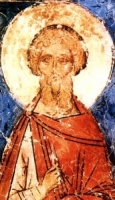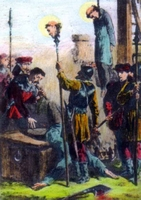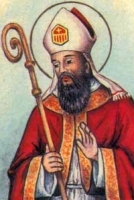St. Patrick of Malaga
Feastday: March 16
Bishop of Malaga, Spain. His life is relatively obscure, but it is believed that he fled to Auvergne, France, during a persecution, where he died. He is still honored in Spain.
Bl. John Cacciafronte
Feastday: March 16
Death: 1183
Bishop and martyr. Born John Sordi in Cremona, he entered the Benedictines and became abbot of St. Lawrence in Creinona in 1155. When the papacy entered into its Struggle with Emperor Frederick I Barbarossa, John sided with the Holy See and was banished. He retired and became a hermit near Mantua, but in 1174 was elevated to the office of bishop of Mantua after its bishop was deposed. After several years, John resigned in favor of the deposed bishop who desired to come back, and in 1177, John went to Vicenza where he was killed by a disgruntled man.
St. Finian Munnu
Feastday: March 16
Death: 635
Irish abbot and disciple of St. Columba and St. Seenell, called St. Mundus in Scotland. He stayed in Cluain Inis, in Ireland, for eighteen years and then went to Jona, Scotland. Returning to Ireland, he founded Taghmon in Wexford and became its abbot. Developing Taghmon into a famous monastery, Finian attended the Magh Lene Synod in 630, defending Celtic liturgical practices. In his later years he suffered from a terrible skin disease, possibly a form of leprosy.
Saint John de Brebeuf
Also known as
Jean
Additional Memorial
19 October as one of the Martyrs of North America
Profile
French Jesuit. He wanted to enter the priesthood from an early age, but his health was so bad there were doubts he could make it. His posting as a missionary to frontier Canada at age 32, however, was a literal god-send. He spent the rest of his life there, and the harsh and hearty climate so agreed with him that the Natives, surprised at his endurance, called him Echon, which meant load bearer, and his massive size made them think twice about sharing a canoe with him for fear it would sink. Brebeuf had great difficulty learning the Huron language. "You may have been a famous professor or theologian in France," he wrote in a letter home, "but here you will merely be a student, and with what teachers! The Huron language will be your Aristla crosse." However, he eventually wrote a catechism in Huron, and a French-Huron dictionary for use by other missionaries.
According to histories of the game, it was John de Brebeuf who named the present day version of the Indian game lacrosse because the stick used reminded him of a bishop's crosier (la crosse).
Saint John was martyred in 1649, tortured to death by the Iroquois. By 1650 the Huron nation was exterminated, and the laboriously built mission was abandoned. But it proved to be "one of the triumphant failures that are commonplace in the Church's history." These martyrdoms created a wave of vocations and missionary fervor in France, and it gave new heart to the missionaries in New France.
Born
1593 at Normandy, France
Died
tortured to death in 1649
Canonized
29 June 1930 by Pope Pius XI
Patronage
Canada
Saint Heribert of Cologne
கொலோன் நகர் பேராயர் ஹெரிபெர்ட் Herbert von Köln
பிறப்பு
970,
வோர்ம்ஸ் Worms, ஜெர்மனி
இறப்பு
16 மார்ச் 1021,
கொலோன் Köln, ஜெர்மனி
இவர் அரசர் ஹூயூகோபின் Hugo மகன். அரசர் 3 ஆம் ஒட்டோ அவர்களால் 994 ல் இவரின் 24 ஆம் வயதில் இத்தாலி நாட்டில் பேராலயக் கவுன்சிலராக தேர்ந்தெடுக்கப்பட்டார். பின்னர் அப்பொறுப்பை ஜெர்மனி நாட்டிலும் ஏற்றார். இவர் அரசர் ஒட்டோவின் நெருங்கிய நண்பரானார். பின்னர் இவர் 995 ல் குருப்பட்டம் பெற்றார். பிறகு 999 ஆம் ஆண்டு கொலோன் நகரின் பேராயராகத் தேர்ந்தெடுக்கப்பட்டார். அப்போது ஒருமுறை 1002 ஆம் ஆண்டு ஒட்டோ பயணம் ஒன்றை மேற்கொண்டபோது, திடீரென்று இறந்து போனார்.
இவ்விறப்பால் பேராயர் ஹெர்பெர்ட் பெரிதும் பாதிக்கபட்டார். இதனால் பல துன்பங்களை அனுபவித்தார். பல்வேறுபட்ட பிரச்சனைகளைச் சந்தித்தார். இவர் ஒட்டோவின் உடலை ஆஹனிற்கு Aachen கொண்டு வரப்பட்டு, அங்கு அடக்கம் செய்யப்பட்டார். ஒட்டோ இறந்ததால் அரசர் 2 ஆம் ஹென்றி பதவி ஏற்றார். அவர் பதவி ஏற்ற நாளிலிருந்து ஆயருக்கு தொல்லை கொடுக்க ஆரம்பித்தான். இதனால் ஆயரை கவுன்சிலர் பதவியிலிருந்து விலக வைத்தான்.
ஆயர் ஹெரிபெர்ட் தான் மேற்கொண்ட அனைத்து துன்பங்களையும் இறைவனின் அருளால் பொறுமையோடு ஏற்றார். தன் பணியை தளராமல் சிறப்பாக ஆற்றினார். ஏழைகளின் மேல் இரக்கங் கொண்டுச் செயல்பட்டார். இவர் இறந்தபிறகு கொலொனிலேயே அடக்கம் செய்யப்பட்டார்.
Also known as
Eriberto, Herbert, Bert, Berti, Berto, Heri, Herko
Profile
Son of Duke Hugo of Worms, Germany. Educated at the cathedral school at Worms. Provost of the cathedral. Ordained in 994. Chancellor for Italy under King Otto III in 994. Chancellor for Germany in 997. Archbishop of Cologne, Germany on 9 July 999. Attended the death-bed of King Otto at Paterno. Initially opposed the ascension of King Henry II, and was imprisoned by him. However, when Henry was elected king on 7 June 1002, Heribert immediately acknowledged him as king, and became one of his advisors. Founded and endowed the Benedictine monastery and church of Deutz, Germany. Obtained miracles by prayer, including the end of a drought. Honoured as a saint even during his lifetime.
Born
c.970 at Worms, Germany
Died
• 16 March 1021 at Cologne, Germany of natural causes
• relics in the church at Deutz, Germany (part of modern Cologne
Canonized
1075 by Pope Saint Gregory VII
Patronage
• against drought
• for rain
• Deutz, Germany
Saint Eusebia of Hamage
Also known as
• Eusebia of Hamay
• Eusebia of Hamaye
Profile
Eldest daughter of Saint Adalbald of Ostrevant and Saint Rictrudis of Marchiennes; great-granddaughter of Saint Gertrude the Elder; sister of Saint Maurontius, Saint Clotsindis, and Saint Adalsindis of Hamay. After her father's murder when she was very young, she was sent to the abbey of Hamage, Doudi, France, which her great-grandmother had founded and served as abbess. Gertrude died when Eusebia was twelve years old; the young girl was elected to replace her. Rictrudis, realizing her daughter had no hope of governing the abbey, but wanting to keep it under the protection of a noble house, merged Hamage with her own house of Marchiennes, and ordered all the sisters to move in together under her rule. Many of the uprooted sisters, including Eusebia, were unhappy with this order as it kept them from obeying Saint Gertrude's last request. After much time and debate, the dissident sisters were permitted to return to their old house, taking Gertrude's relics with them, and taking Eusebia as their abbess. The delay had allowed her to grow into the position, and she proved an excellent abbess.
Born
c.640
Died
• c.680 of natural causes
• buried at her abbey church
Blessed John Sordi
Also known as
• John Cacciafronte
• Giovanni de Surdis Cacciafronte
• John de Surdis
Profile
Benedictine monk at the abbey of Saint Lawrence in Cremona, Italy. Abbot in 1155. Sided with the Pope against Emperor Frederick Barbarossa, and so was banished from the abbey by the emperor. Hermit near Mantua, Italy.
Bishop of Mantua in 1174, replacing a bishop removed for transgressions in office. In 1177, his predecessor repented, returned, and requested the return of his see. John asked permission to resign, return the mitre to the previous bishop, and return to his life as a hermit. The request was granted, and John transferred to Vicenza, Italy.
John was murdered by a man who had embezzled Church funds, and whom John was reprimanding. As John died working for the Church, and correcting a sinner, he is considered a martyr.
Born
c.1125 at Cremona, Italy as John Sordi
Died
murdered on 16 March 1183 at Vicenza, Italy
Beatified
30 March 1824 by Pope Leo XII
Saint Julian of Anazarbus
Also known as
• Julian of Antioch
• Julian of Tarsus
• Julian of Cilicia
• Giuliano...
Profile
Prominent citizen of senatorial rank. Arrested for his faith during the persecutions of Diocletian, he was tortured then put on display for abuse for a year in cities all over Cilicia, being led around behind a camel. Martyr. Praised by Saint John Chrysostom in a homily during the enshrinement of his relics.
Born
Anazarbus, Cilicia (in modern Turkey)
Died
• sewn into a sack full of vipers and scorpions, and thrown into the sea to drown c.302
• relics enshrined in Antioch
Blessed John Amias
Also known as
John Anne
Additional Memorial
29 October as one of the Martyrs of Douai
Profile
Married layman cloth merchant in Wakefield, England. Father of several children. A widower, he divided his property among his children, and studied for the priesthood in Rheims, France. Ordained in 1581. He returned to England as a home missioner to covert Catholics. Arrested at the home of a Mr Murton in Lancashire for the crime of priesthood. Martyred with Blessed Robert Dalby.
Born
at Wakefield, West Riding, England
Died
hanged, drawn, and quartered on 16 March 1589 at York, England
Beatified
15 December 1929 by Pope Pius XI
Saint Finian Lobhar
புனித_ஃபின்னியன்_லோபர் (-560)
மார்ச் 16.
இவர் (#StFinnianLobhar) அயர்லாந்தைச் சார்ந்தவர்.
புனித கொலம்பியாவின் சீடரான இவர், அவரிடம் பயிற்சி பெற்று, குளோமோர் என்ற இடத்தில் தங்கி கோயிலையும் துறவுமடத்தையும் கட்டி, இறைப்பணியைச் செய்து வந்தார்.
இதற்கு இவர் டப்ளின் என்ற இடத்திற்கு அருகிலுள்ள ஓர் இடத்தில் துறவுமடத்தை நிறுவி, துறவு மட அதிபராகப் பணியாற்றினார். அங்கு இவர் தொழுநோயால் பாதிக்கப்பட்ட ஒரு சிறுவனை நலமாக்கினார்.
ஒருசில ஆண்டுகள் துறவு மட அதிபராகப் பணியாற்றிவிட்டு, முன்பிருந்த இடத்திற்கே திரும்பி வந்து, இறைவேண்டலிலும் நோன்பிலும் தன் நாள்களைச் செலவழித்து, இறுதியில் தன் ஆன்மாவை ஆண்டவனிடம் ஒப்படைத்தார்.
Also known as
• Finian Lobur
• Finian the Leper
• Finnian...
• Fintan...
Profile
Disciple of Saint Columba. Founded a church and monastery at Innisfallen, Ireland. Monk at Clonmore, Ireland. Abbot of Swords abbey near Dublin, Ireland. In his later years he retired to Clonmore to spend his last days as a prayerful monk. He was called Lobhar (the Leper) because he briefly contracted leprosy when he miraculously cured a young boy of the disease.
Born
at Bregia, Leinster, Ireland
Died
c.560 at Clonmore, Ireland of natural causes
Blessed Robert Dalby
Additional Memorial
29 October as one of the Martyrs of Douai
Profile
Protestant minister. Convert to Catholicism. Studied in Douai and Rheims in France. Ordained in 1588, he returned to England to minister to covert Catholics. Arrested for the crime of priesthood in 1589, he was martyred with Blessed John Amias.
Born
at Hemingborough, Yorkshire, England
Died
hanged, drawn, and quartered on 16 March 1589 at York, England
Beatified
15 December 1929 by Pope Pius XI
Saint Dentlin of Soignies
Also known as
Dentelin, Denain
Profile
Son of Saint Vincent Madelgarus and Saint Waldetrudis; brother of Saint Landric, Saint Madalbarta and Saint Aldetrudis. Nephew of Saint Aldegund. An extraordinarily pious child, he is considered a confessor of the faith. A church in Cleves, Germany, was named for him.
Died
• at age 7 in 7th century of natural causes
• buried in Soignies, Belgium
• relics transferred to the abbey church in Rees, Germany in the 1040's
• miracles reported at his tomb
Patronage
Rees, Germany
Saint Abban of Kill-Abban
Also known as
• Abban of Magheranoidhe
• Abban of Murneave
• Abban of Murnevin
• Abbán moccu Corbmaic
• Eibbán, Moabba
Profile
Contemporary of Saint Patrick. Founded Kill-Abban abbey in Leinster, Ireland, and served as its first abbot. Founded the convent for Saint Gobnait of Ballyvourney, Ireland.
Born
Irish
Died
5th century Ireland of natural causes
Patronage
• Cell Abbáin, Ireland
• Killabban, Ireland
• Mag Arnaide, Ireland
Saint Megingaud of Würzburg
Also known as
Megingoz, Mengold, Megingaudus
Profile
Benedictine monk at the monastery of Fritzlar, Germany, in 738. Teacher at the abbey school. Abbot at Fritzlar. Bishop of Würzburg, Germany in February 754. In 769 he retired to Neustadt abbey to spend his last days as a prayerful monk.
Born
710 in Franconia
Died
783 at the abbey of Neustadt, Germany of natural causes
Blessed Torello of Poppi
Profile
After a wild and misspent youth, Torello lived 60 years as a hermit in a walled-up cave. Vallombrosan oblate.
Born
1201 or 1202 at Poppi, Tuscany, Italy
Died
between 1281 and 1292 at Poppi, Tuscany, Italy of natural causes
Beatified
by Pope Benedict XIV (cultus confirmed)
Patronage
Poppi, Italy
Saint Hilary of Aquileia
Also known as
Elaro, Ellaro, Hilarius, Ilario
Profile
Bishop of Aquileia, Italy. His prayers would cause the collapse of pagan temples and idols. Martyred in the persecutions of Numerian by order of the prefect Beronius.
Died
tortured to death on 16 March c.284
Patronage
Gorizia, Italy
Blessed Ferdinand Valdes
Profile
Mercedarian friar. Priest. Bishop of Lugo, Spain. Royal chaplain to the court of Castile.
Died
• Saint Catherine monastery, Toledo, Spain
• body found incorrupt after 300 years
Blessed Joan Torrents Figueras
Profile
Claretian priest. Martyred in the Spanish Civil War.
Born
8 December 1873 in La Secuita, Tarragona, Spain
Died
16 March 1937 in Montcada, Barcelona, Spain
Venerated
21 December 2016 by Pope Francis
Saint Benedicta of Assisi
Profile
Poor Clare nun. Succeeded Saint Clare of Assisi as abbess of Saint Damian's abbey at Assisi, Italy.
Died
1260 of natural causes
Saint Gregory Makar
Also known as
• Gregor Makar
• Gregory of Nicopolis
Profile
Armenian monk. Bishop of Nicopolis, Armenia. Became a hermit at Pithiviers, Orleans, France.
Died
c.1000
Saint Tatian of Aquileia
Also known as
Taziano
Profile
Deacon in Aquileia, Italy. Martyred in the persecutions of Numerian.
Died
beheaded c.284
Patronage
Gorizia, Italy
Blessed Eriberto of Namur
Profile
The details of this person's life have been lost.
Died
relics enshrined in a Marian chapel in the Saint Alban cathedral in Bois-Vlilliers, Namur, Belgium
Saint Dionysius of Aquileia
Also known as
Denis of Aquileia
Profile
Layman in Aquileia, Italy. Martyred in the persecutions of Emperor Numerian.
Died
beheaded c.284
Saint Largus of Aquileia
Profile
Christian lay man in Aquileia, Italy. Martyred in the persecutions of Numerian.
Died
beheaded c.284
Saint Papa of Seleucia
Also known as
Papas
Profile
Martyr.
Born
Lycaonia, Asia Minor
Died
Seleucia, Persia
Saint Felix of Aquileia
Profile
Layman in Aquileia, Italy. Martyred in the persecutions of Numerian.
Died
beheaded c.284
Saint Agapitus of Ravenna
Also known as
Agapetus, Agapito
Profile
Fourth century bishop of Ravenna, Italy.
Saint Malcoldia of Asti
Profile
Benedictine nun. Anchoress at Asti, Italy.
Died
c.1090 of natural causes
Saint Aninus of Syria
Profile
Hermit and miracle worker in Syria.
புனிதர் கிளெமன்ட் மேரி ஹொஃப்பௌவர்
(St. Clement Mary Hofbauer)
மறைபணியாளர், மத குரு, வியன்னாவின் அப்போஸ்தலர்:
(Religious, Priest and Apostle of Vienna)
பிறப்பு: டிசம்பர் 26, 1751
டப்விட்ஸ், ஸ்நோஜ்மோ மாவட்டம், போஹெமியா அரசு, ஹப்ஸ்பர்க் பேரரசு
(Taßwitz, Znojmo District, Kingdom of Bohemia, Habsburg Empire)
இறப்பு: மார்ச் 15, 1820
வியன்னா, ஆஸ்டிரியன் பேரரசு
(Vienna, Austrian Empire)
ஏற்கும் சமயம்:
ரோமன் கத்தோலிக்க திருச்சபை
(அதிதூய மீட்பர் சபை மற்றும் வியன்னா உயர்மறை மாவட்டம்)
(Roman Catholic Church)
(Congregation of the Most Holy Redeemer & Archdiocese of Vienna)
முக்திபேறு பட்டம்: ஜனவரி 29, 1888
திருத்தந்தை பதின்மூன்றாம் லியோ
(Pope Leo XIII)
புனிதர் பட்டம்: மே 20, 1909
திருத்தந்தை பத்தாம் பயஸ்
(Pope Pius X)
நினைவுத் திருநாள்: மார்ச் 16
பாதுகாவல்:
வியன்னா, ஆஸ்திரியா
(Vienna, Austria)
புனிதர் கிளெமன்ட் மேரி ஹொஃப்பௌவர், ஒரு "மொராவியன் துறவியும்" (Moravian Hermit) பின்னர், "மீட்பர் சபையின்" (Redemptorist Congregation) மத குருவும் ஆவார். இவர் தமது சபையை இத்தாலியின் "ஆல்ப்ஸ்" மலைகளின் வடக்கே நிறுவினார். ஐரோப்பாவின் கொந்தளிப்பான வறுமையின் கோரப்பிடியில் ஆயிரக்கணக்கான மக்கள் பலியான காலகட்டத்தில், இவர் தமது வாழ்நாள் முழுவதையும் ஏழைகளின் சேவையில் அர்ப்பணித்தார். போலிஷ் (Polish people) மக்களின் சேவையில் தம்மை ஈடுபடுத்திய இவர், அங்கிருந்து ஆஸ்திரியா நாட்டுக்கு நாடுகடத்தப்படும்வரை போலிஷ் மக்களுக்கு சேவை புரிந்தார். “வியன்னாவின்” (Vienna) இணை பாதுகாவலரான இவர், தமது அளப்பற்ற தன்னலமற்ற சேவைகளுக்காக "வியன்னாவின் அப்போஸ்தலர்" (Apostle of Vienna) என்று அழைக்கப்பட்டார்.
"ஜோஹன்னஸ் ஹொஃப்பௌவர்" (Johannes Hofbauer) எனும் இயற்பெயர் கொண்ட இவர், புனிதர் ஸ்தேவானின் (Saint Stephen) நினைவுத் திருநாளான 1751ம் ஆண்டு, டிசம்பர் மாதம், 26ம் நாளன்றும், "மரியா ஸ்டீர்" (Maria Steer) மற்றும் “பவுல் ஹொஃப்பௌவர்" (Paul Hofbauer) ஆகிய பெற்றோருக்கு பிறந்த பன்னிரண்டு குழந்தைகளில் ஒன்பதாவது குழந்தையாகப் பிறந்தார். கிளமென்ட்டுக்கு ஆறு வயதாகையில் இவரது தந்தை மரித்தார். ஏழை விதவைத் தாயார் இவர்களை வளர்க்க கஷ்டப்பட்டார். குரு மாணவராக சேர அல்லது மத சபையொன்றில் இணைய கிடைத்த சிறு வாய்ப்பைப் பயன்படுத்தி, இலத்தீன் மொழி கற்க தொடங்கினார். அவரது உள்ளூர் பங்கின் பங்குத்தந்தையே அவருக்கு கற்பித்தார். கிளமென்ட்டின் குருத்துவ வாழ்வின் நெடிய பயணம் தொடங்கியது. இவருக்கு பதினான்கு வயதாகையில், இவருக்கு இலத்தீன் மொழி கற்பித்த பங்குத்தந்தையின் திடீர் மரணம் காரணமாக, சட்டென இவரது படிப்பு நின்றுபோனது. புதிதாக வந்த பங்குத்தந்தைக்கு, இவருக்கு கற்பிப்பதற்கான நேரம் கிடைக்கவில்லை.
தொடர்ந்து குருத்துவம் கற்க கையில் பணம் இல்லாத நிலையில், ஏதாவது ஒரு கைத்தொழிலோ, வியாபாரமோ கற்க வேண்டிய அவசியத்திலிருந்த கிளமென்ட், ஒரு துறவு மடத்தின் ரொட்டி முதலானவை செய்து விற்கும் பணியகம் (Bakery) ஒன்றில் பயிற்சியாளராக சேர்ந்தார். துறவு மடமென்பதால் அங்கேயே உள்ள இலத்தீன் பள்ளியின் வகுப்புகளுக்குச் சென்று கற்றுக்கொள்ள அனுமதிக்கப்பட்டார். ஆனால், சிறிது காலத்தில் அத்துறவு மடத்தின் மடாதிபதியின் மரணத்தின் பின்னர், கிளமென்ட் துறவு வாழ்க்கைக்கு முயற்சித்தார். ஆனால், “பேரரசர் இரண்டாம் ஜோசப்” (Emperor Joseph II) “ஹப்ஸ்பர்க்” (Habsburg Empire) பேரரசிலுள்ள அனைத்து ஆசிரமங்களை ஒழித்தார். இதன் காரணமாக கிளமென்ட் மீண்டும் வியன்னா திரும்பி ரொட்டித் தொழிலில் இணைந்தார்.
மழைக்காலத்தின் ஒருநாள், புனித ஸ்தேவான் பேராலயத்தில் (Cathedral of St. Stephen), திருப்பலியின் பின்னர் மழையில் காத்திருந்த இரண்டு பெண்களுக்காக வண்டி ஒன்றை அழைத்து வந்தார் கிளமென்ட். அவருடன் அப்பெண்கள் நடத்திய சிறு சம்பாசனையில், வறுமையின் காரணமாக அவரால் குரு கல்வி கற்க இயலவில்லை என்பதனை அறிந்துகொண்டனர். தாராள மனம் கொண்ட அப்பெண்களிருவரும் குரு கல்வி கற்க கிளமென்ட்டுக்கும் அவருடைய நண்பரான "தடேயஸ்" (Thaddeus) என்பவருக்கும் உதவுவதாக கூறினர்.
மகிழ்ச்சியுடன் ரோம் நகர் சென்ற நண்பர்கள் இருவரும் புனிதர் அல்ஃபோன்சஸ் லிகொரியின் (Saint Alphonsus Liguori) "மீட்பர் சபையினரால்" (Redemptorist Congregation) ஈர்க்கப்பட்டனர். 1785ம் ஆண்டு, இவ்விரு இளைஞர்களும் குருத்துவ அருட்பொழிவு பெற்றனர்.
புதிதாக குருத்துவம் பெற்ற இருவரும் வியன்னாவுக்கு அனுப்பப்பட்டனர். ஆனால், அங்கிருந்த மதச் சிக்கல்களால் அவர்கள் அங்கிருந்து கிளம்பி, போலந்தின் "வார்சாவ்" (Warsaw, Poland) சென்றனர். அங்கே அவர்கள் இயேசு சபையினர் ஒடுக்கப்பட்டதால், குருக்கள் இல்லாது விடப்பட்ட ஜெர்மன் மொழி பேசும் எண்ணற்ற கத்தோலிக்கர்களை காண நேர்ந்தது. ஆரம்பத்தில் மிகவும் வறுமையிலேயே வாழ நேர்ந்த அவர்களால் வெளியிடங்களிலேயே மறை போதனை செய்ய இயன்றது. இறுதியில், அவர்களுக்கு புனித "பென்னோ" (St. Benno) தேவாலயம் கொடுக்கப்பட்டது. பின்னர் சுமார் ஒன்பது வருடங்கள் வரை அவர்கள் தினமும் ஐந்து முறை மறைபோதனை நிகழ்த்தினர். மூன்று மறைபோதனைகள் போலிஷ் மொழியிலும் இரண்டு மறைபோதனைகள் ஜெர்மன் மொழியிலும் நிகழ்த்தினர். எண்ணற்ற பிற இன மக்களை கத்தோலிக்க விசுவாசத்துக்கு மனம் மாற்றினர். அவர்கள் ஏழைகளுக்கான சமூக சேவைகளிலும் சுறுசுறுப்பாக இயங்கினர். அனாதைகளுக்கான இல்லம் ஒன்றினை நிறுவினர். ஆண்களுக்கான பள்ளி ஒன்றினையும் நிறுவி நடத்தினர்.
மேலும் பலரை சபைக்கு ஈர்த்த இவர்கள் போலந்து (Poland), ஜெர்மனி (Germany) மற்றும் ஸ்விட்ஸர்லாந்து (Switzerland) ஆகிய நாடுகளுக்கு மறை பணியாளர்களை அனுப்பினர். ஆனாலும், அப்போதிருந்த மத, அரசியல் பதற்ற சூழ்நிலைகளால் இவர்களது நிறுவனங்கள் அனைத்தும் இறுதியில் கைவிடப்பட்டன. இருபது வருட கடின உழைப்பின் பின்னர் கிளமென்ட் கைது செய்யப்பட்டு சிறை செய்யப்பட்டார். பின்னர் அங்கிருந்து நாடு கடத்தப்பட்டார்.
மீண்டுமொரு கைதின் பின்னரே அவரால் வியன்னா சென்றடைய முடிந்தது. அங்கேயே பன்னிரண்டு வருடங்கள் தமது வாழ்க்கையின் இறுதி கால பணி புரிந்தார். ஏழை பணக்காரன் என்ற வித்தியாசம் பார்க்காமல் பாவ மன்னிப்பு வழங்கினார். நோயுற்றோரை காணச் சென்றார். அதிகார வர்க்கத்தினருக்கு ஆலோசகராக இருந்தார். தமது தூய்மையை நகரின் அனைவருக்கும் பகிர்ந்தார். அவர் மிகவும் நேசித்த அவரது நகரில் ஒரு கத்தோலிக்க கல்லூரியை ஸ்தாபித்ததுவே அவர் செய்த சீரிய பணிகளில் சிகரமாய் அமைந்தது. விரைவிலேயே அவர் "வியன்னாவின் அப்போஸ்தலர்" (The Apostle of Vienna) என்றழைக்கப்பட்டார்.
துன்புறுத்தல்கள் அவரையும் தொடர்ந்தன. அதிகாரத்திலிருந்த சிலரால் அவரின் மறை போதனைகளை சில காலம் வரை நிறுத்தி வைக்க இயன்றது. அவரை அகற்றிவிட உயர் பதவி வகித்தவர்களால் ஒரு முயற்சி கூட நடந்தது. ஆனால் அவரது தூய்மையும் புகழுமே அவரை இரட்சித்ததுடன், "மீட்பர் சபையினரின்" (Redemptorist Congregation) வளர்ச்சிக்கு தூண்டுகோலாக இருந்தது. அவரது மரணம் சம்பவித்த 1820ம் வருடம், கிளமென்ட்டின் பெருமுயற்சியால் "மீட்பர் சபை", "வடக்கு ஆல்ப்ஸ்" (North of the Alps) பகுதியில் ஸ்திரமாக நிறுவப்பட்டது.










